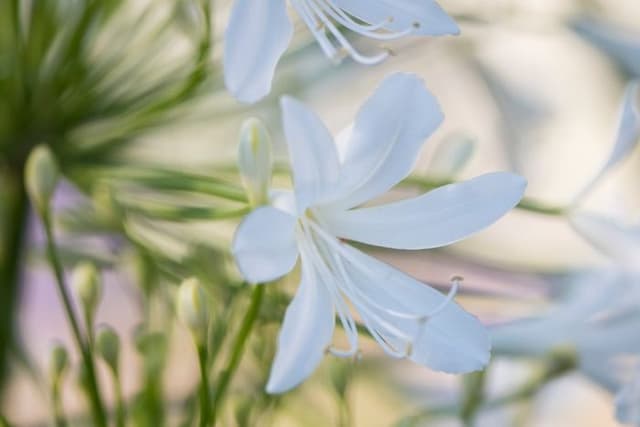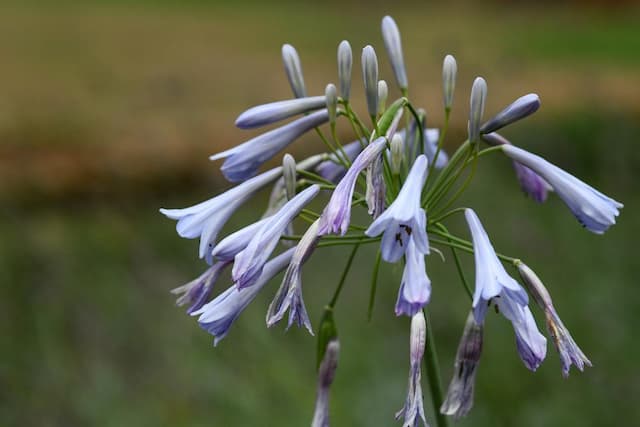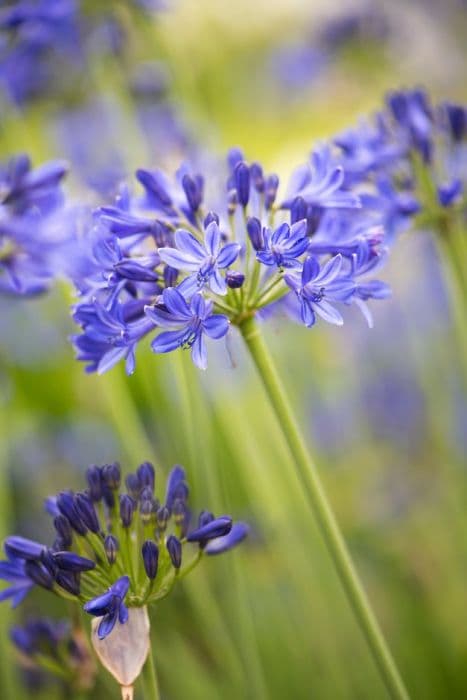Agapanthus 'Peter Pan' ambig.

ABOUT
Agapanthus 'Peter Pan' is an ornamental garden plant commonly known as Lily of the Nile, although it is not a lily and is not native to the Nile region. This perennial boasts striking features, starting with its lavish foliage composed of strap-like, glossy, green leaves that form an elegant fountain-like clump. From this lush base, multiple stems arise, each culminating in a spherical cluster of trumpet-shaped flowers. The blooms are a soft blue to violet color, presenting a cool and calming appearance. The individual flowers are small and numerous, creating a sense of fullness and abundance in the rounded flower heads which are typically seen nodding gently above the leaves on their slender stalks during the blooming season. The plant exudes an overall graceful and delicate appearance, making it a popular choice for borders, containers, and as a focal point in gardens.
About this plant
 Names
NamesSynonyms
Dwarf Lily of the Nile, Miniature African Lily, Peter Pan Agapanthus
Common names
Agapanthus 'Peter Pan'
 Toxicity
ToxicityTo humans
The plant commonly known as Lily of the Nile can be toxic if ingested by humans. All parts of the plant contain substances that may cause symptoms if ingested, which can include nausea, vomiting, and diarrhea. The sap may also cause skin irritation or allergic reactions in some individuals. The severity of symptoms can vary depending on the amount consumed, but medical advice should be sought if ingestion occurs.
To pets
Lily of the Nile is toxic to pets if ingested. The toxic components are present in all parts of the plant, including the leaves, stems, and flowers. If a pet consumes parts of this plant, symptoms may include vomiting, diarrhea, abdominal pain, drooling, and in some cases, tremors or cardiac issues. It is vital to prevent pets from chewing on or ingesting any part of this plant, and if a pet is suspected to have ingested some of it, immediate veterinary attention is recommended.
 Characteristics
CharacteristicsLife cycle
Perennials
Foliage type
Evergreen
Color of leaves
Green
Flower color
Blue
Height
1-2 feet [30-60 cm]
Spread
1-2 feet [30-60 cm]
Plant type
Herb
Hardiness zones
8
Native area
South Africa
Benefits
 General Benefits
General Benefits- Low maintenance: Peter Pan Agapanthus is known for being easy to care for, which makes it suitable for gardeners of all skill levels.
- Drought tolerance: Once established, it has a good tolerance for dry conditions, reducing the need for frequent watering.
- Attracts pollinators: The flowers of the Peter Pan Agapanthus attract bees, butterflies, and other beneficial insects to the garden.
- Long blooming season: It boasts a lengthy blooming period through the summer months, providing long-lasting visual interest.
- Versatility in landscaping: Suitable for use in borders, containers, and as a focal plant, it offers flexibility in garden design.
- Showy flowers: The plant produces attractive clusters of blue or purple flowers that enhance the aesthetic appeal of any garden space.
- Compact size: With a smaller stature, it fits well in gardens where space is limited, without overwhelming other plants.
- Erosion control: The root system of Peter Pan Agapanthus can help to stabilize soil and prevent erosion on slopes.
- Deer resistance: It is generally not preferred by deer, which can be advantageous in areas where deer browsing is a problem.
 Medical Properties
Medical PropertiesThis plant is not used for medical purposes.
 Air-purifying Qualities
Air-purifying QualitiesThis plant is not specifically known for air purifying qualities.
 Other Uses
Other Uses- Environmental Education Tool: Agapanthus can be used in educational settings such as schools and botanical gardens to teach students about plant biology, growth cycles, and horticulture.
- Bee and Butterfly Attractant: The nectar-rich flowers of Agapanthus attract pollinators such as bees and butterflies, making it a beneficial plant for promoting biodiversity in gardens.
- Theme Gardens: Agapanthus 'Peter Pan' can be used in theme gardens, such as 'Peter Pan' or fairy tale-themed spaces, to add whimsy and a touch of magic due to its name and delicate appearance.
- Floral Art and Ikebana: The long stems and striking flowers of Agapanthus make it suitable for use in floral arrangements and Japanese ikebana, providing vertical interest.
- Photography Prop: Photographers may use Agapanthus as a background or focal point for garden photography, benefiting from their vibrant color and structure.
- Property Value Enhancement: Strategically planted Agapanthus can enhance the curb appeal and value of properties by creating attractive borders and highlights in landscaping.
- Ground Stabilization: When planted on slopes or in areas prone to erosion, the root systems of Agapanthus can help stabilize the soil and prevent erosion.
- Eco-Friendly Confetti: Dried Agapanthus petals can be used as a biodegradable alternative to traditional paper confetti at events such as weddings.
- Craft Projects: Both fresh and dried flowers of Agapanthus can be incorporated into various craft projects, such as wreaths, pressed flower art, or potpourri.
- Culinary Garnish: Although not widely known for culinary uses, the flowers of Agapanthus may be used as an ornamental edible garnish on plates, provided they have not been treated with pesticides.
Interesting Facts
 Feng Shui
Feng ShuiThe Agapanthus, commonly known as Lily of the Nile, is not specifically used in Feng Shui practice.
 Zodiac Sign Compitability
Zodiac Sign CompitabilityThe Agapanthus, commonly known as Lily of the Nile, is not used in astrology practice.
 Plant Symbolism
Plant Symbolism- Love: The name 'Agapanthus' is derived from the Greek words 'agape' (love) and 'anthos' (flower), symbolizing a love of flowers or a love that is strong and binding.
- Beauty: Agapanthus, with its striking blue to purple flowers, commonly signifies beauty and a sense of wonder, reflecting its attractive blooms.
- Fertility: Due to its lush and proliferative growth, agapanthus can represent fertility and abundance.
- Endurance: Being a hardy plant that can thrive in tough conditions, agapanthus is often associated with endurance and surviving through hardships.
- Freedom: The open-form of the agapanthus flower can symbolize freedom and openness, much like its expansive bloom.
 Water
WaterFor Agapanthus 'Peter Pan', commonly known as Dwarf Lily of the Nile, it is recommended to water the plant deeply when the top inch of soil feels dry to the touch, typically every 7 to 10 days, depending on the climate and season. During hot and dry periods, you may need to water the plant more frequently. Use about 1 to 2 gallons of water per plant for each watering session, ensuring even moisture distribution throughout the root zone. During the winter months or in cooler climates, reduce the frequency of watering to prevent waterlogging, as this plant prefers well-drained soil.
 Light
LightDwarf Lily of the Nile thrives in full sun to partial shade conditions. It is best to place the plant in a spot where it can receive at least 6 hours of sunlight daily. Partial shade is beneficial in areas with intense afternoon sun to protect the plant from scorching, especially in hotter climates.
 Temperature
TemperatureThe Dwarf Lily of the Nile can tolerate a temperature range from about 20°F to 100°F. The ideal temperature for promoting healthy growth and blooms is between 60°F and 80°F. The plant can survive minor frosts but should be protected from prolonged periods of freezing temperatures.
 Pruning
PruningPruning Dwarf Lily of the Nile involves removing spent flower stems and old foliage to encourage new growth and maintain an attractive appearance. Prune back the dead stems in late fall or early spring before new growth begins. Pruning is not required frequently but should be done yearly to keep the plant looking tidy and promote healthy, abundant blooms.
 Cleaning
CleaningAs needed
 Soil
SoilThe best soil mix for Agapanthus 'Peter Pan', commonly known as Dwarf Lily of the Nile, is a well-draining soil with a slightly acidic to neutral pH between 6.0 and 7.0. A blend of loamy soil, compost, and perlite or coarse sand can provide the necessary drainage and nutrients.
 Repotting
RepottingDwarf Lily of the Nile should be repotted every two to three years or when it becomes root-bound. Repotting is best done in the spring before the growing season begins.
 Humidity & Misting
Humidity & MistingThe Dwarf Lily of the Nile prefers moderate humidity levels but can tolerate a range. Maintaining a humidity level between 40-60% is generally conducive to its growth.
 Suitable locations
Suitable locationsIndoor
Place in bright, indirect light and keep moderately watered.
Outdoor
Plant in partial sun, shelter from harsh winds.
Hardiness zone
8-10 USDA
 Life cycle
Life cycleThe life of Agapanthus 'Peter Pan', commonly known as Lily of the Nile or African Lily, begins with germination, where the seeds sprout in moist soil conditions after a period of dormancy. Following germination, the seedling stage involves the growth of roots and the emergence of the first leaves, which will photosynthesize to provide energy for growth. As the plant enters the vegetative stage, it develops a clump of strap-like leaves and continues to grow, storing energy in its rhizomatous root system. When mature, Agapanthus 'Peter Pan' produces tall flower stalks with globular clusters of attractive blue or purple flowers during the blooming period, which usually takes place in summer. After pollination, the flowers will develop into seed pods containing seeds that, when mature, are dispersed to start a new cycle. As a perennial, once the blooming is finished, the plant will enter a period of dormancy, often in the colder months, before resuming growth in the following spring.
 Propogation
PropogationPropogation time
Spring-Early Summer
Propogation: The Agapanthus 'Peter Pan', commonly known as Dwarf Lily of the Nile, is best propagated through division, which is typically done in the spring or early fall. This method involves carefully removing the plant from the soil and separating the clump into smaller sections, each with a portion of root and at least one growing point. These divisions can then be replanted directly into the garden or into pots with well-draining soil, spaced at least 12 inches (approximately 30 centimeters) apart to allow room for growth. Watering should be consistent to establish the new plants. This straightforward approach encourages healthy propagation without the need for specialized equipment or techniques and adheres to the plant's natural growth habits for successful multiplication.







![African lily [Brilliant Blue]](/_next/image?url=https%3A%2F%2Fplants-admin.emdemapps.com%2Fimages%2Fplants%2F%2Fimages%2F604b5e3c28e2b.png&w=640&q=75)

